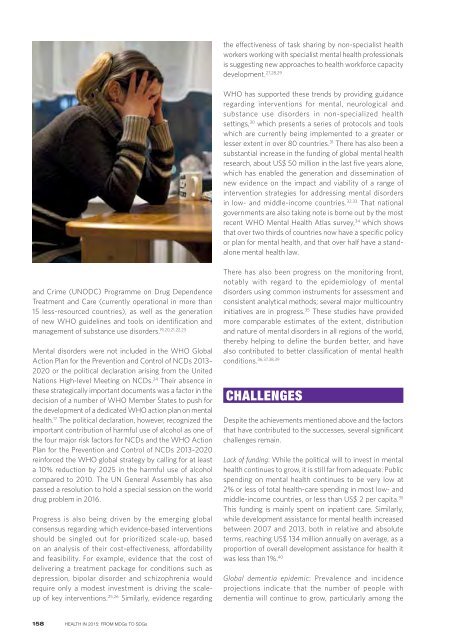Create successful ePaper yourself
Turn your PDF publications into a flip-book with our unique Google optimized e-Paper software.
the effectiveness of task sharing by non-specialist health<br />
workers working with specialist mental health professionals<br />
is suggesting new approaches <strong>to</strong> health workforce capacity<br />
development. 27,28,29<br />
WHO has supported these trends by providing guidance<br />
regarding interventions for mental, neurological and<br />
substance use disorders in non-specialized health<br />
settings, 30 which presents a series of pro<strong>to</strong>cols and <strong>to</strong>ols<br />
which are currently being implemented <strong>to</strong> a greater or<br />
lesser extent in over 80 countries. 31 There has also been a<br />
substantial increase in the funding of global mental health<br />
research, about US$ 50 million in the last five years alone,<br />
which has enabled the generation and dissemination of<br />
new evidence on the impact and viability of a range of<br />
intervention strategies for addressing mental disorders<br />
in low- and middle-income countries. 32,33 That national<br />
governments are also taking note is borne out by the most<br />
recent WHO Mental Health Atlas survey, 34 which shows<br />
that over two thirds of countries now have a specific policy<br />
or plan for mental health, and that over half have a standalone<br />
mental health law.<br />
and Crime (UNODC) Programme on Drug Dependence<br />
Treatment and Care (currently operational in more than<br />
15 less-resourced countries), as well as the generation<br />
of new WHO guidelines and <strong>to</strong>ols on identification and<br />
management of substance use disorders. 19,20,21,22,23<br />
Mental disorders were not included in the WHO Global<br />
Action Plan for the Prevention and Control of NCDs 2013–<br />
2020 or the political declaration arising <strong>from</strong> the United<br />
Nations High-level Meeting on NCDs. 24 Their absence in<br />
these strategically important documents was a fac<strong>to</strong>r in the<br />
decision of a number of WHO Member States <strong>to</strong> push for<br />
the development of a dedicated WHO action plan on mental<br />
health. 17 The political declaration, however, recognized the<br />
important contribution of harmful use of alcohol as one of<br />
the four major risk fac<strong>to</strong>rs for NCDs and the WHO Action<br />
Plan for the Prevention and Control of NCDs 2013–2020<br />
reinforced the WHO global strategy by calling for at least<br />
a 10% reduction by 2025 in the harmful use of alcohol<br />
compared <strong>to</strong> 2010. The UN General Assembly has also<br />
passed a resolution <strong>to</strong> hold a special session on the world<br />
drug problem in 2016.<br />
Progress is also being driven by the emerging global<br />
consensus regarding which evidence-based interventions<br />
should be singled out for prioritized scale-up, based<br />
on an analysis of their cost-effectiveness, affordability<br />
and feasibility. For example, evidence that the cost of<br />
delivering a treatment package for conditions such as<br />
depression, bipolar disorder and schizophrenia would<br />
require only a modest investment is driving the scaleup<br />
of key interventions. 25,26 Similarly, evidence regarding<br />
There has also been progress on the moni<strong>to</strong>ring front,<br />
notably with regard <strong>to</strong> the epidemiology of mental<br />
disorders using common instruments for assessment and<br />
consistent analytical methods; several major multicountry<br />
initiatives are in progress. 35 These studies have provided<br />
more comparable estimates of the extent, distribution<br />
and nature of mental disorders in all regions of the world,<br />
thereby helping <strong>to</strong> define the burden better, and have<br />
also contributed <strong>to</strong> better classification of mental health<br />
conditions. 36,37,38,39<br />
CHALLENGES<br />
Despite the achievements mentioned above and the fac<strong>to</strong>rs<br />
that have contributed <strong>to</strong> the successes, several significant<br />
challenges remain.<br />
Lack of funding: While the political will <strong>to</strong> invest in mental<br />
health continues <strong>to</strong> grow, it is still far <strong>from</strong> adequate. Public<br />
spending on mental health continues <strong>to</strong> be very low at<br />
2% or less of <strong>to</strong>tal health-care spending in most low- and<br />
middle-income countries, or less than US$ 2 per capita. 35<br />
This funding is mainly spent on inpatient care. Similarly,<br />
while development assistance for mental health increased<br />
between 2007 and 2013, both in relative and absolute<br />
terms, reaching US$ 134 million annually on average, as a<br />
proportion of overall development assistance for health it<br />
was less than 1%. 40<br />
Global dementia epidemic: Prevalence and incidence<br />
projections indicate that the number of people with<br />
dementia will continue <strong>to</strong> grow, particularly among the<br />
158 HEALTH IN 2015: FROM MDGs TO SDGs


